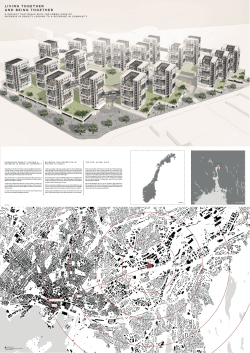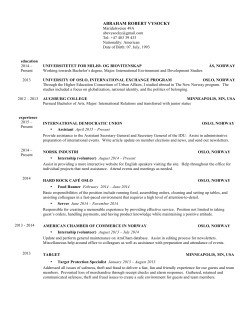
How to make Oslo more innovative?
Why is Oslo not Innovative? A Review of the Constraints & Challenges PD Phil Cooke, Director, Centre for Advanced Studies, Cardiff University; Development Studies, Aalborg University; & Management School, University of Florence Competitiveness 2009-10 Sources: WEF Global Competitiveness Report, 2010-2011 and IMD World Competitiveness Yearbook 2011 Ranking Switzerland Sweden Singapore USA Germany Japan Finland Netherlands Denmark Canada Hong Kong Ukraine Taiwan Norway France Australia WEF Competitiveness 2010 1 2 3 4 5 6 7 8 9 10 11 12 13 14 15 16 WEF Competitiveness 2009 1 2 3 4 5 7 6 8 9 10 11 13 12 14 15 16 IMD Competitiveness 2010 5 4 3 1 10 26 15 14 12 7 1 57 6 13 29 9 European Innovation Performance Source: Innovation Union Scoreboard (IUS) 2010 (SII Summary Innovation Index) Sweden Denmark Finland Germany UK Belgium Austria Netherlands Ireland France EU Iceland Slovenia Estonia NORWAY Portugal Italy Czechia Spain Greece Hungary Croatia 75 73 70 68 65 63 59 58 57 54 52 49 48 47 46 44 43 42 39 37 34 30 European Union Innovation Scoreboard Source: The 2007 Summary Innovation Index (SII) EU Interpretation of Innovation Groupings • Estonia, Australia, Norway, Czech Republic, Slovenia, Italy, Cyprus and Spain are the moderate innovators with SII scores below that of the EU27. • Sweden, Switzerland, Finland, Israel, Denmark, Japan, Germany, the UK and the US are the innovation leaders, with SII scores well above that of the EU27 and most other countries. Sweden has the highest SII of all countries, but its leading position is mostly based on strong inputs. • Luxembourg, Iceland, Ireland, Austria, the Netherlands, France, Belgium and Canada are the innovation followers, Technology Intensity in Total Value Added by Source Source: OECD Technology Intensity • This means that countries are ranked according to total business technology intensity • Table shows that the share of own R&D activity of business enterprises is about one-half of the total business R&D content in countries with a relatively high level of GDP per capita • It is below this share in countries with lower level of income. Norway’s GDP to Innovation is a low Ratio • The ration of GDP level to innovation performance is moderate • For unclear reasons high GDP is not translated into high innovation • This can have three sources: – Low investment of high GDP by business in innovation – Low government investment in innovation – Low production of innovation by other institutions e.g. universities • On investigation of the input-output ratio of Norwegian effort seems to give poor returns • All countries spend more on inputs than they get back in innovation outputs, • However, Norway gets a bit less than half the investment in innovation returns • Other countries, nearer the top of the performance range e.g. Switzerland and Germany, get more innovation input for output Selected European Knowledge Economy Disparities Region >40% Knowledge Economy Region <40% Knowledge Economy EU Position Stockholm (S) London (UK) Gothenburg (S) Gilf’d-Bri’t’n (UK) Bergen (NO) Oslo (NO) Trondheim (NO) Helsinki (Fi) Paris (Fr) Stavanger (NO) Utrecht (NL) Denmark (DK) Edinburgh (UK) Wales (UK) Dublin(IR) 58.65 57.73 53.70 53.17 52.42 52.23 52.10 51.50 50.17 48.76 47.49 47.46 47.05 43.39 40.18 (1) (2) (3) (4) (6) (7) (9) (14) (15) (22) (29) (30) (33) (59) (89) EU Position Gelderland (NL) Düsseldorf (G) Väli-Suomi (Fi) Hannover (G) N.E. Scotland (UK) Namur (BE) Lombardia (I) Liguria (I) N. Ireland (UK) Pais Vasco (E) Emilia-Romagna (I) H. & Islands (UK) Cataluña (E) Navarre (Sp) Aegean Islands (Gr) 39.99 39.37 39.10 38.27 38.09 37.70 37.55 37.35 37.31 36.30 35.22 34.45 33.48 32.06 12.70 (91) (104) (105) (109) (110) (112) (114) (115) (116) (119) (130) (136) (141) (149) (192) Source: Cooke & De Laurentis (2002) EU Knowledge Economy Index, Cardiff, Centre for Advanced Studies Interpreting Knowledge Economy Indicators • Knowledge –intensive business services plus high tech manufacturing • Oslo and Norway’s other main cities have very high KIBS ratios • All cities and regions have much smaller HTM than KIBS • KIBS are not occupations but sectoral employment, (e.g. banking, administration, management, consultants) • Many such posts are routine rather than ‘innovative’ Oslo’s Innovation Advantages and Challenges • Karlsson 2001, Isaksen, 2003 and Aslesen 2007 found Oslo to be competitive, export-minded and innovative in software engineering • In software, Oslo was more export and innovationminded than Stavanger or Trondheim • Characteristic of Oslo software were some university Internet start-ups, venture capital and consultancies selling services to larger Oslo firms • Oslo had no greater intensity in R&D investment than some medium cities on turnover from exports and percentage of turnover invested in innovation Oslo’s Challenge • Could it be that Oslo’s innovators occupy ‘bloody red water’ of high competition for low margins? • We know Oslo suffers from high overhead costs, so can enjoy only limited innovation margins except in very high value-added activity • Notice the ‘smiling curve’ of added value in the following slide The ‘smiling curve’ of added value in ICT Global Innovation Networks (GINs) Synthetic Design Symbolic Design Contract Manufacturing Electronic Contract Manufacturing Original Design Manufacturing Flagship Marketers, Apple, Google ‘Android’, Silicon Valley, Taiwan, Seoul, South Korea, Cambridge TIS, ARM, CSR Chip Design Value ‘Apps’ Design, Silicon Valley, ‘Silicon Roundabout’, Toronto, Malmö Original Design Manufacture TIS Mediatek, Taiwan Contract Manufacturing Platform, ‘World Factory’, Shenzhen, Dongguan, Shanghai Electronic Contract manufacturing, Guangdong GIN-TIS Flagship Markets How did the ‘smiling curve’ happen? • Chipset Design & Advanced GIN Logistics • Territorial Innovation Systems In ICT GIN Agent: e.g. ‘Apps’ UX-UI, LBS @ TAT, Polar Rose & Malmö, Ottawa, Silicon Valley Platforms PPlatformsPlatformsPlatf orms Principal: e.g. Apple, SonyEricsson, HP, Nokia Agent: e.g. Advanced Embedded Software & Systems @ ARM, Autonomy CSR, & Cambridge Platform Agent: e.g. ‘World Factory’ Contract Manufacturing Platform @ Foxconn, Celestica, Sanmina, Flextronics & Shenzen, Dongguan platforms Sub-Agents: ODM (Original Design Manufacturers) e.g. Compal, Arima, Hong Hai @ Taiwan Sub-Agents: EMS (Electronic Contract Manufacturing), e.g. PCBs, Cables, PC Parts, Metals Västra Götaland region’s ‘Iconic Projects’ resilience to ‘eco’ and ‘healthcare’ shocks Tunnel Infrastructure Visioning Sustainable City Recycling Renewable Fuels Forest Plastics Greenshipping Health Imaging Green Procurement Medtech GU/CH Research Goteborg BIO Green Logistics Auto Safety Medtech Environment Recycling Digital Signals Processing Biodiagnostics ICT Healthcare Petroleum & Health Smart Textiles Pharma Complex Systems: What’s Going On? • Regional Innovation Systems are helping firms find innovative partners outside their sector • Innovative firms are seeking ‘relatedness’ from ‘strange attractors’ • Policy ‘emergence’ from below up to the global (Gothenburg model of Lisbon Agenda) • Innovation by Cross-pollination • Inkjet printer now used in Clothing, Ceramics, and Shoes clusters/industries Discussion & Conclusions • Norway is wealthy in narrowly specialised fields • These are related, too, but are big and independent, oil, offshore engineering, shipping, energy • Innovation comes from ‘recombination of knowledge’ (Schumpeter) • Innovator city-regions are ‘thinking laterally’ not only ‘vertically’
© Copyright 2025










